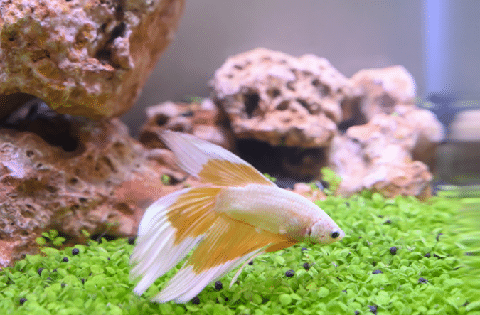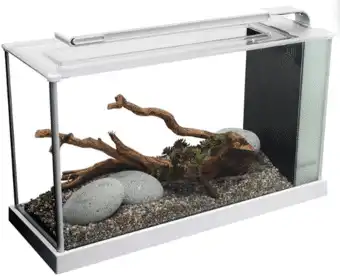Thank you for visiting! By the way… any links on this page that lead to products on Amazon and other stores/partners are affiliate links Aquarium Store Depot earns a commission if you make a purchase.
In the aquarium hobby, betta fish is as old as the hills. And no wonder people love it so much that they always keep at least one in their aquarium. Out of many fascinating reasons why betta fish became so popular, one is their amazing size!
So how big do Betta Fish Get? - Betta fish or Siamese fighting fish grow to an average length of 2.5 to 3 inches.
However, you’ll be surprised to know that there are different parameters that influence betta fish size. In this article, we’ll discuss everything about betta fish growth.
Stay with me!
Key Takeaways
- Most Betta fish species grow to around 2.5 to 3 inches in length maximum.
- The wild bettas may seem smaller in size than the captive counterparts due to their short finnage.
- The minimum tank size for healthy growth is at least a five-gallon aquarium.
- Betta fish care with a balanced diet and a well-maintained clean tank is an essential factor in letting your betta grow to its full size.
- During the first few days, the baby betta fish solely relies on the nutrients absorbed by the yolk sac and doesn’t need any additional food.
How Big Do Betta Fish Get?
As mentioned above, the average size of a full-grown betta fish is around 2.5 to 3 inches in length. However, some betta variants, like the giant betta fish tend to grow larger and can reach an average size of 4 inches in length and more. The size of your betta fish largely depends on many factors, such as water quality, food and diet, and a healthy environment.
How About In The Wild?
In their natural habitat, wild betta fish are the same size as their captive counterparts. However, due to their different colorful and body appearance (since wild bettas possess smaller fins), they might appear smaller in size.
Also, betta fish in the wild, are always in the fight or flight response, hence, always in stress. Therefore, their capacity to grow is not enough as compared to the captive, colorful species of home aquariums.
What Is The Minimum Tank Size For Them?
Many aquarists believe that betta fish will grow to the size of their tank. However, this is not the case. Betta fish may require free swimming space because an inadequate living environment may lead to a range of other health issues, including stunted growth in the fish species1.
Generally speaking, a small tank size will hinder the betta fish growth, with internal organs growing to their full potential. This results in various health issues and reduced lifespan.
The minimum recommended tank size for a full-grown betta fish is a 5 gallon tank. The bigger, the better! That’s because smaller tanks accumulate waste products quickly, such as Ammonia, nitrites, and nitrates, that suppress the growth of fish and lead to more susceptible diseases.
Betta fish living and thriving in larger tanks are known to have a healthy life and larger fins, contributing to their overall size.
How Fast Do They Get To Adult Size?
Like other fish, betta fish grow the most during their early life stages and reach their full potential after 6 to 7 months of birth. It doesn’t take very long for baby bettas to get to become fully grown betta fish if kept in the right conditions.

However, there are a variety of factors that play a crucial role in their overall growth. For example, water quality and water parameters.
After the first few days of hatching, betta fry absorbs the nutrients from the yolk sac and doesn’t need any additional food. However, after a few weeks, they begin to move and eat microscopic food, such as infusoria. During this time period, the growth is quick with high-quality feedings. Once your fish is 1 to 2 months of age, betta fish eat brine shrimp or blood worms.
However, 2 to 3 months is an important age for growth and development. During this time period, betta fish require a high amount of protein to become big with vibrant colors and healthy long fins.
After 6 months, the betta fish is considered an adult, and their growth rate will slow down at this point considerably.
How To Make Them Grow Faster
We all know that betta fish are considerably smaller fish than many fish species. However, with the right and healthy fish environment, they get reach their maximum size; 3 inches in length.
Of course, to achieve a bigger and more beautiful betta fish, you need to work hard!
Tank Size
First of all, consider the tank size. Many pet stores keep betta fish in small containers, cups, or tiny bowl to save space because you can keep a single betta fish in a small container. This practice is detrimental to the mental and physical well-being of your betta fish and may affect their growth adversely. Therefore, it’s essential to provide at least 5-gallon fish tanks for your betta’s healthy survival.
The Best Betta Fish Tank
Best filtration, best light, perfect size and with everything you need to get started. It was made for Bettas!
Clean tank
Make sure to do 20% water changes every other way for a healthy and bigger Betta fish. That’s because betta fish excrete a lot of waste and a hormone that inhibits their growth. Therefore, removing at least 20% of water every other day is crucial for their maximum growth.
Water temperature
Maintaining a temperature range of 72 to 83 degrees is crucial to keep the body working properly because temperature changes can be stressful to your fish, inhibiting their growth.
Balanced diet
A balanced diet is key to the healthy survival of your betta fish. Make sure the diet of your fish contains lots of fiber and protein. You may feed your fish bloodworms, earthworms, freeze-dried bloodworms, and freeze-dried foods to encourage healthy growth. Only feed twice or thrice a day and remove the leftover food to prevent water contamination.
Water quality
Besides being a hardy fish, Betta splendens are still prone to many common aquatic diseases. Therefore, pristine water conditions combined with a balanced diet and well-maintained aquariums with live plants or fake plants can lower the stress.
Lighting conditions
The right lighting conditions are essential for the proper growth of your betta fish. Make sure to provide a natural light pattern for your bettas. i.e., natural day and light patterns. This means that only natural lighting is not enough.
Proper artificial lighting that are dimmable or adjustable are highly recommended. Also, it’s important to place your tank in the right location where it doesn’t allow direct sunlight. For example, away from windows and doors because direct exposure to sunlight cause serious issues in water parameters. Ultimately affecting the health of your bettas. Additionally, natural sunlight may encourage algae infestation in your tank.
Proper filtration
Many aquarists believe betta fish grow just fine in an unfiltered tank, but I’ve noticed a significant difference in the health and growth of Bettas that grow in a filtered tank.
I highly suggest installing a filter if your tank is bigger than 5 gallons to keep water conditions pristine and in optimal ranges for proper maintenance.
Filters reduce the production of harmful bacteria and parasites in your tank and help with oxidation and nitrification.
Choosing the best filter for your betta fish depends on various factors such as your tank size, the number of fish in your tank, etc. Just remember that Bettas are not good swimmers, so strong water currents may stress them out. Therefore, an adjustable power filter is highly recommended.
FAQS
Do betta fish grow in bigger tanks?
Even though the tank size doesn’t influence the growth of betta fish much, bigger tanks are still recommended because lack of free swimming space may cause an inadequate living environment for the fish which may lead to many fish diseases, including stunted growth.
Is it better to have 1 or 2 betta fish?
If you have a small tank—5 or 10 gallons, then it’s not recommended to keep more than one betta fish. However, if you have bigger tanks over 20 gallons, you can keep two betta fish in the same tank.
How big of a tank do I need for a betta fish?
The minimum tank size for a single betta fish is 5 gallons. However, if you want to keep two or more, you should get a tank bigger than 20 gallons.
Can betta fish grow bigger?
When provided with pristine water conditions and balanced food, betta fish grow to its full potential, 3 inches in length. But anything above 3 inches is nearly impossible.
Can a betta have too big of a tank?
No. There’s nothing as a huge tank for Betta. Betta splendens are highly active fish with filters and heaters installed for their healthy and happy survival. Therefore, if you can accommodate and afford a bigger tank for your fish, happily provide them with all the space they deserve!
How big should my betta fish grow when they breed?
The best time for your betta fish to breed is around 6 to 18 months because they are now adults and in their fittest form.
Are female betta fish and male betta fish the same size?
No, upon careful examination, you will notice that male betta fish have thicker bodies and larger fins and bodies than female betta fish. The average size of male bettas is around 2.5 inches to 3 inches. However, female bettas reach a maximum of 2.5 inches in size.
Final Thoughts
How big do bettas get is not a mystery anymore! The average betta fish grows around 3 inches in length, which is quite small as compared to other freshwater fish. However, make sure to provide them with the best water conditions, water temperature, and diet requirements and you’ll have beautiful happy friends for years to come.
- About the Author
- Latest Posts
I’m thrilled that you found Aquarium Store Depot! Here you’ll find information on fish, aquariums, and all things aquatics related. I’m a hobbyist (being doing this since I was 11) and here to help other hobbyists thrive with their aquariums! I adhere to a high quality Editorial Process and Review products with real life field usage and practical analysis.






